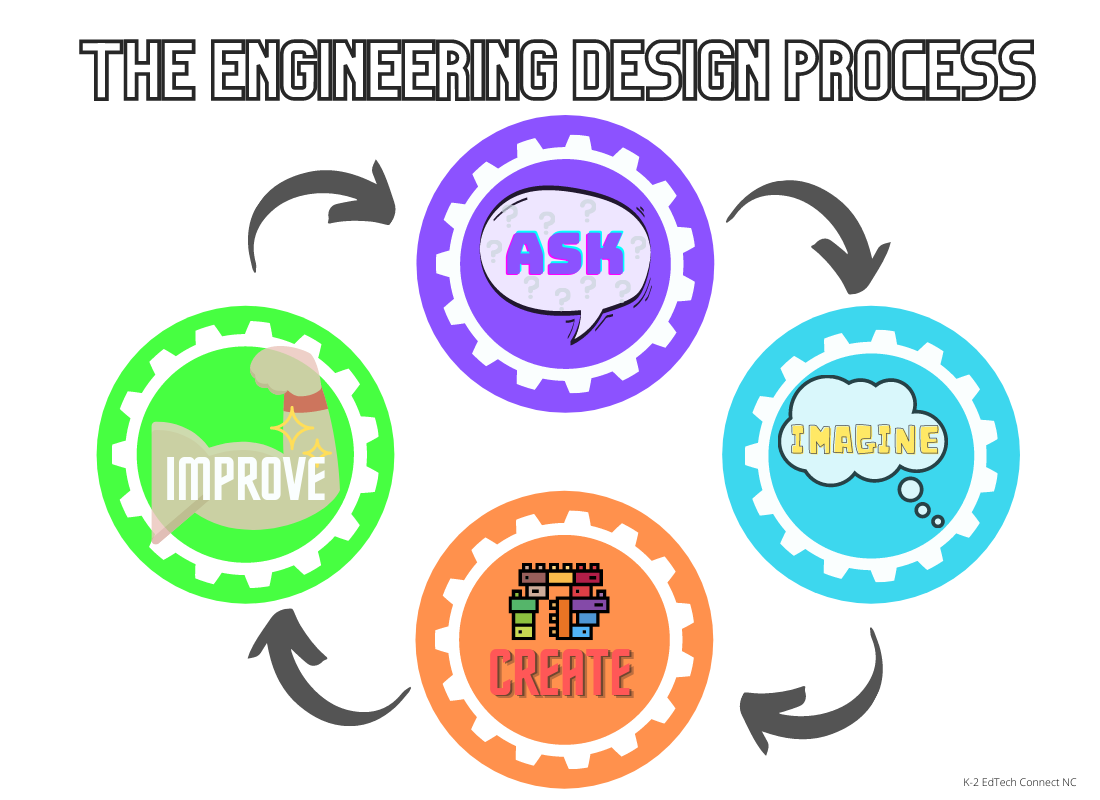Know and use a deliberate design process | Little Engineers | K-2

Student Objective
Students will be able to:
1. Name the steps of a deliberate design process: The Engineering Design Process.
2. Use the Engineering Design Process to create a unique solution to a common problem.
3. generate ideas, test their ideas and create artifacts as solutions to a common problem.
Instructions
Materials needed for this activity:
- computer
- a way to present a video from YouTube and/or powerpoint presentation
- chart paper or the chart image provided within the activity
Materials needed for the “experiment” in the short video:
- paper
- rulers
- pencils
- plastic forks
- modeling dough
- paper towel roll
- tape
*any of these materials can substituted for similar items: objects that provide length or can be used to scratch your back
Step 1: Generate a connection and add context/relevancy for using the Engineering Design Process in real-life.
In this introduction, you want to give students the opportunity to connect with the lesson in a personal way. You will give a personal example of when you used a problem-solving process to create a solution to an issue in your life.
This connection should provide context to using the Engineering Process in a format that relates to their own lives.
An example of a connection you could provide
Step 2: Review and watch the beginning of this video by SciShow Kids called, Jessi Has a Problem. [stop the video at 3:15]
Explain that this video is about Jessi and Squeaks.
“Jessi has a problem in this video that we are going to help her solve. But first, she is going to teach us about a process that will gives us steps to help her solve her problem. Are you ready to watch?”
You can watch the beginning of this video in 2 different parts or all together. Here are the suggested segments of the video:
-
- An introduction to the profession of Engineers: What their job entails and how they do their job [through 1:11 in video].
- The steps of the engineering design process. They are introduced as: Ask, Imagine, Create and Improve [through 3:15 in video].
Step 3: Discuss the 4 steps of The Engineering Design Process and create an anchor chart for future reference
There are 2 options for creating and/or displaying the Engineering Design Process:
- Make a chart together as a class, discussing each step in detail
- Use a pre-made chart [like this basic chart or this detailed chart] and display the pre-made chart while going over each step
Make sure to go over each step discussed in the video, in order. You can also explain that this is the process we will be using to solve Jessi’s problem, and a process we can use to solve other problems as well (make a connection to your story from the introduction)
Step 4: Finish the video and introduce the class activity
Start the video at 3:15, and watch until the end. Jessie will introduce her problem and will give a list of materials they can use to create a solution to her problem. You can use these materials or other similar objects.
Step 5: Pass out materials and have students go through the Engineering Design Process to create solutions to Jessi’s problem
Follow each step of the process with the students, helping them through the process of designing, creating, and improving their projects. Depending on their familiarity with the activity you can talk them through each step or allow them to work through it independently.
*It is suggested to begin individually or a group of 2 students, until students are familiar with working in larger groups to produce 1 product.
Steps 2 & 3 can be used to introduce or reinforce The Engineering Design Process and used for other problem solving activities.
Tips for introducing younger students to collaborating and creating 1 project together, with minimal conflict. [ISTE standard 7c.Contribute constructively to project teams]
Justification
This instructional idea introduces students to the design process by providing a structure that represents each step of the engineering design process. The students will relate the design process within a fun and relevant topic.
